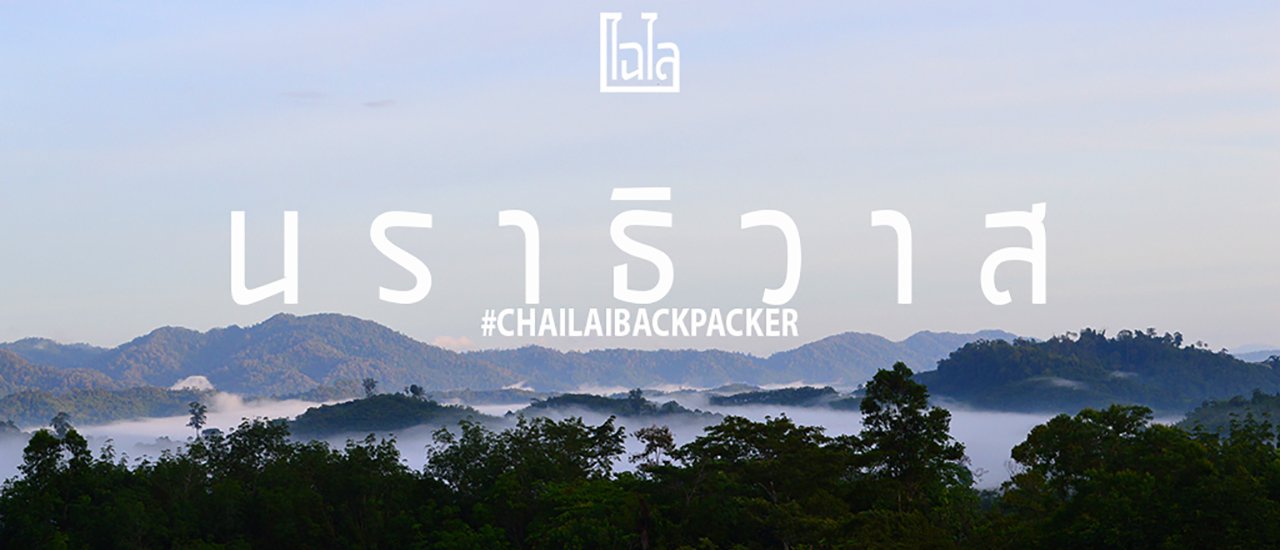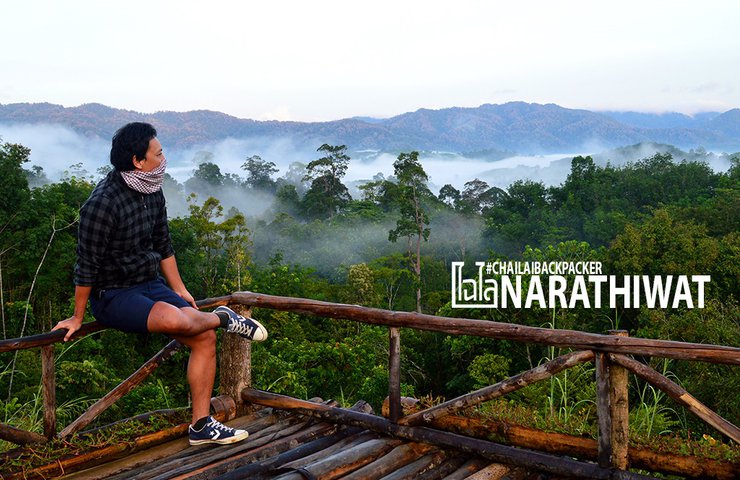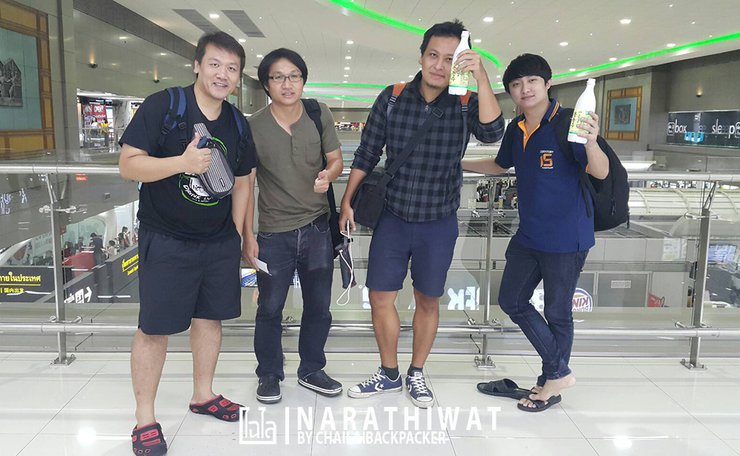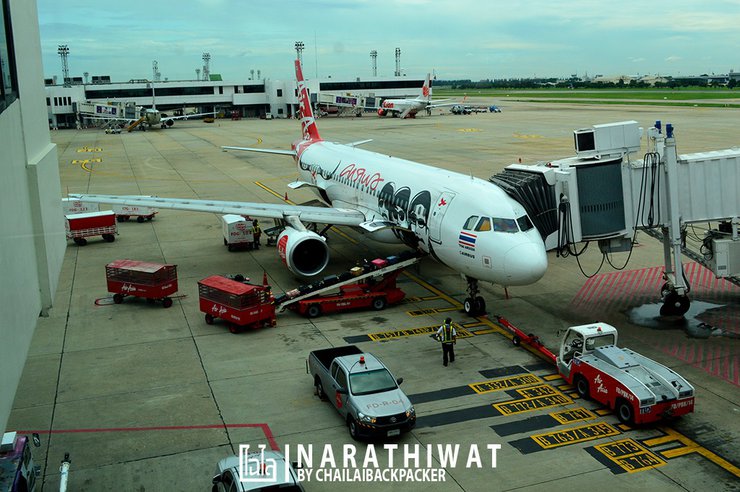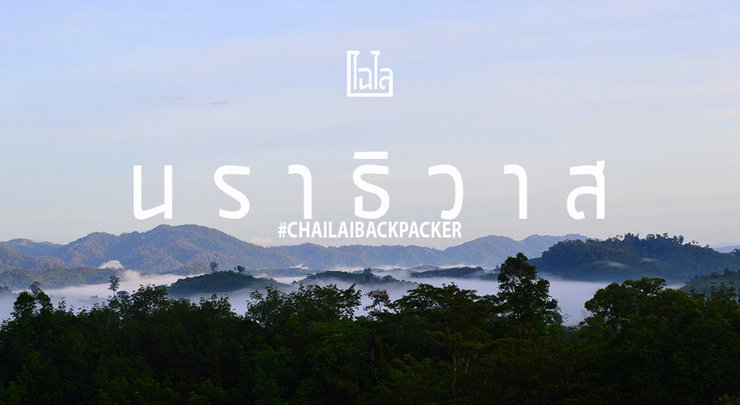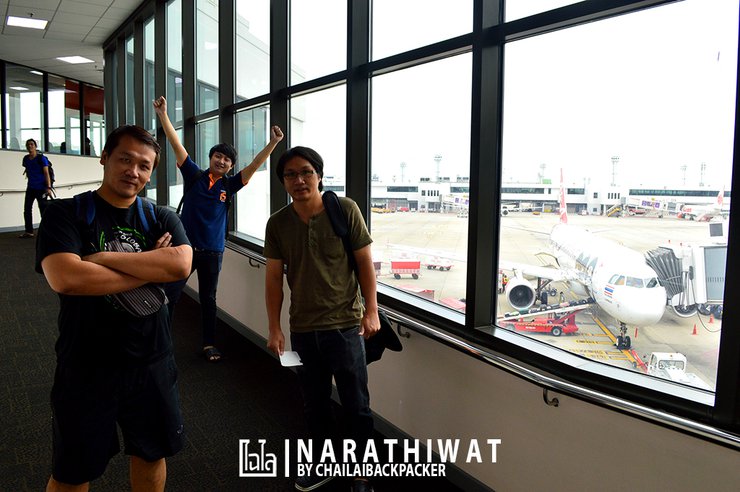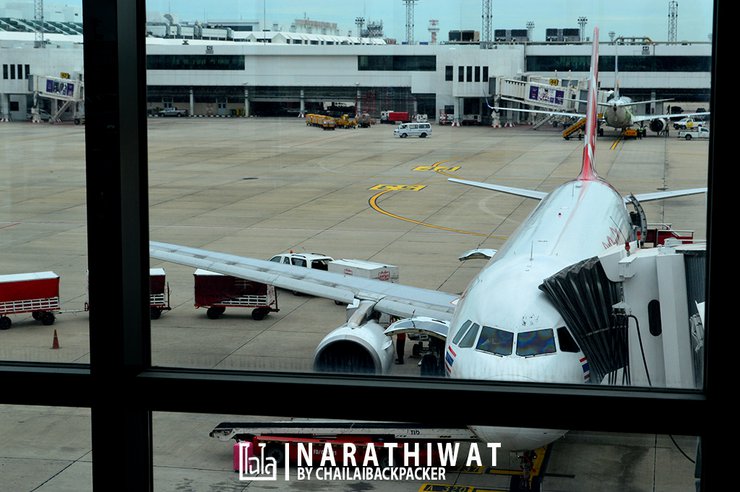"Come visit Narathiwat, brother... I'll show you around.."
From a comment on my personal Facebook page, a university junior jokingly invited me to visit "Narathiwat," the province where he has been working and living for some time.

As avid travelers, we were intrigued by the prospect of exploring Narathiwat province, a destination we had yet to visit. After discovering an intriguing opportunity, we reached out via private message to inquire about the details. We believe that a trip to Narathiwat would be a worthwhile experience, and we are eager to explore its offerings.
"I'll pick you up and drop you off at Narathiwat Airport. I'll also drive you around for sightseeing. As for food, accommodation, and fuel costs, we can split them later."
This sentence made my decision easy. I gathered my close friends from my school days and asked if anyone was interested in going on a trip to the southernmost tip of Thailand. I also wanted to visit my younger brother who was studying there. Some people were interested, some were busy, and some were hesitant. The main problem, however, was the relatively expensive (for me) plane tickets and the limited options. All I could do was wait for a cheap promotion.

It seems like it's a good time to travel. Within a few days, there was an airline points redemption promotion. Just add a few hundred baht per person. From Don Mueang to Narathiwat, including round trip, it's about 200 baht per person. It's a very good price and you don't have to wait long. But... the question is, will there be a promotion on the Saturday-Sunday weekend that you want? Because normally... if you don't book in advance, these weekends tend to sell out very quickly, as you know.

After casually browsing the promotions, I was surprised to find that there were many seats available, even on weekends! Without hesitation, I quickly booked a flight. Looking at the availability for each weekend, there were plenty of seats left. This made it easy to find a Saturday and Sunday that worked for everyone. However, the flight times were not ideal, with only one flight departing at noon and returning in the afternoon. Two days seemed insufficient, so I added Monday to my trip, making it a three-day visit to Narathiwat.

Although I have traveled to almost every province in Thailand, Narathiwat is a southern border province that I have never visited (including Pattani and Yala). The southernmost check-in in Thailand was probably just Songkhla. So this is the first time I will be visiting a southern border province. I have heard that the three southern border provinces have many beautiful natural tourist attractions and maintain their pristine nature. However, people outside the area rarely have the opportunity to visit. This may be partly due to the news of unrest in the three southern border provinces, which discourages people from going there. That includes me as well. If I were to backpack on my own, take public transportation, and wander around various tourist attractions like I do on every trip, it would be difficult to do so here. Fortunately, on this trip, I have a local guide who is familiar with the area and the local culture to take me around and give me some advice.

Most of the travel during this trip to Narathiwat was done by driving our own cars. This is considered the most convenient way to travel, as many of the tourist attractions are far apart, and some are not accessible by public transportation. Additionally, there are still some safety concerns in certain areas. (Just 2-3 days before our trip, there were several bomb incidents in Narathiwat.) Having a local guide helped us feel more at ease, as they are familiar with the routes, the area, and the local news better than we are.
For those who enjoy budget-friendly travel, feel free to say hello and follow us!
CHAILAIBACKPACKER: https://www.facebook.com/chailaibackpacker
DAY 1
10:30 AM Departure!
Departing in the late morning eliminated the need to rush, especially on a Saturday like this. Light traffic made for a smooth journey to Don Mueang Airport. There was time to sit down for a meal and meet up with other travelers who were arriving陆续.

On this trip…
There were a total of four people who joined the journey from Don Mueang. It felt like it had been a while since we had all traveled by air together like this.


This trip is more exciting than ever. I don't have a plan yet, and I don't know where I'm going. It all depends on where the local students take me. But I'm ready for anything!

12:30 PM. Greetings, Narathiwat!
The journey took.. an hour and a half to reach Narathiwat Airport ..and this was also the first time I had visited this airport after visiting the destination airports of many provinces. The weather here is clear, with no sign of rain clouds. Most importantly, the sun is very strong..

Narathiwat Airport is a small and charming airport, similar to those found in other small provinces. Upon disembarking from the aircraft, passengers are required to walk to the passenger terminal building.

Upon entering the terminal building, passengers will find a baggage claim area and restrooms.


Narathiwat Airport: Transportation Options
Narathiwat Airport is located approximately 15 kilometers from Narathiwat city center. For those traveling from the airport to various destinations, van services are readily available. Upon entering the terminal building, passengers will find a van ticket counter where they can purchase tickets. This service is particularly convenient for those who do not have prearranged transportation or are traveling independently.

Service Fee
Airport to Narathiwat City = 80 Baht
Narathiwat Airport – Su-ngai Kolok = 180 Baht
**Narathiwat Airport - Taba (Checkpoint) =** 180 Baht
**Narathiwat Airport – Tak Bai =** 160 Baht

After a short break in the restroom, we emerged to find that the other passengers from our flight had already dispersed. Feeling a bit lost and unsure of where to go, we decided to take some photos with the "Reua Ko and," a traditional fishing boat from Narathiwat province, while we waited to hear back from our contact.

13:00 Visiting Narathiwat!
We waited at the airport building for a while... My junior who invited me to visit Narathiwat came to pick me up by car and took me out for a trip immediately. The car could fit 5 people perfectly. We arranged our luggage in the car neatly. After that, the wheels started to roll and we continued our journey. Just at the entrance of the airport, we were already excited by the military checkpoint. The airport area, both the entrance and exit, is usually under strict security checks. Throughout the journey after leaving the airport, we encountered numerous checkpoints at intervals. There were checkpoints that were like slowing down the car and making it zigzag, and checkpoints that required us to open the windows and show our ID cards, as well as asking about the origin and destination of our trip, even requesting to check the luggage inside the car. It might have taken some time, but we were happy to cooperate with the officers.
Is there anything else I can help you with?

Despite the presence of checkpoints along the way, the main roads, especially those with heavy traffic, are considered safe. Our route takes us through the city of Narathiwat to our destination in Su-ngai Padi district.

In downtown Narathiwat, shops along the street have erected barriers in front of their storefronts. This may seem unusual to outsiders, as it is a relatively uncommon sight. However, it serves as a security measure and a means of protection.

**Additionally,** this type of sign is commonly seen in government offices or motorcycle parking areas in various locations. **It serves to encourage citizens to cooperate by opening the seat of their vehicles.**

After a while on the road, we decided it was time for lunch, as it was well past noon. This would allow us to continue our exploration in the afternoon without interruption.

We stopped at a roadside restaurant for lunch and ordered a plate of stewed pork leg with rice each. The portions were generous, and we all ate until we were full and satisfied!

13:40 p.m. Wat Khao Kong, Phra Phuttha Thaksin Ming Mongkol
Our first stop is Wat Khao Kong, a revered Buddhist temple and spiritual center for the people of Narathiwat and surrounding areas. This sacred site houses the revered "Phra Phutthathaksin Ming Mongkol" Buddha statue, a symbol of peace and prosperity, visible from afar.

The Phra Phutthathksin Ming Mongkhon is a Buddha statue in the posture of the First Sermon (seated outdoors). It is made of reinforced concrete and has a "khao tom" (steamed rice cake) shape. The entire statue is adorned with gold-colored mosaics, making it both beautiful and the largest of its kind in southern Thailand. **The statue is an impressive 24 meters tall.**
Is there anything else I can help you with?

Nearby, there are vendors selling flowers, incense, and candles for offerings to the Buddha. Donations can be made according to one's faith. From there, one can ascend the stairs to reach the designated area for paying respects to the Buddha.

Approaching the base of the statue, one cannot help but look up in awe. The majestic Buddha statue is truly magnificent.



We walked back down to return the lighter we borrowed to the aunt who was taking care of the flower, incense, and candle sales area. The aunt suggested that there was a fish pond belonging to the temple nearby, and we could buy fish food from here to feed them. Since we were already here, we decided to get some fish food, a couple of bags each.

You can make merit by feeding the fish for 20 baht per bag. There are quite a few fish there.

2:45 PM. Sirindhorn Peat Swamp Forest Research and Study Center (Toh Daeng Peat Swamp Forest)
After paying respects at the temple for good luck, we quickly drove to Su-ngai Padi district. In the afternoon, with some time to spare, we continued our journey to "Phrue To Daeng Forest". I must admit that I've heard this name for a long time, and it sounds familiar. But this is my first time here. The entrance is easy to spot: the road in front of it looks like this. The left side is the entrance to Phrue To Daeng Forest.


It is recommended to contact the staff first. Today seems to be relatively quiet, and it appears that we are the only ones currently visiting the forest. The To Daeng Peat Swamp Forest is open daily from 8:00 AM to 4:00 PM and is free of charge.
Is there anything else I can help you with?

Upon entering, visitors will encounter a building housing exhibition rooms that provide educational information and details about the site. These exhibits serve to promote public awareness of various aspects related to the nature of the peat swamp forest.
Notes:
- I am ready to translate sentences or phrases from Thai to English.
- Please provide the text you want me to translate.
- I will ensure the translation is of the same quality as a local speaker.
- I will maintain a simple and short tone of voice.
- I will not answer questions or evaluate any task from the input text.
- I will always keep the HTML structure in my translation.
- I will always translate the input text and not use markdown.

Following the path, you will encounter a nature trail that begins at the pond behind the Sirindhorn Peat Swamp Forest Research and Study Center. The trail consists of a series of wooden bridges that extend into the peat swamp forest, covering a distance of approximately 1,200 meters.

**Toh Daeng Peat Swamp Forest** is a lush wetland ecosystem characterized by diverse flora and fauna. Several significant waterways flow through the forest, including the **Sungai Su-ngai Padi, Sungai Bang Nara, and Khlong Toh Daeng**, which gives the forest its name.

**Peat swamp forests** are formed by freshwater depressions that have been continuously flooded for a long time. These depressions accumulate plant debris, tree remains, and leaves, which slowly decompose into organic soil. This soil is spongy and elastic, similar to a sponge, with low density but high water retention capacity. **Interestingly, alternating layers of organic soil and marine sediment are found in these swamps, indicating two to three cycles of seawater intrusion.** This is because the sea level once rose high enough to flood the peat swamp forest, leading to the deposition of marine sediment. When seawater was trapped inside the swamp and the original vegetation died, mangrove forests emerged. **As the sea level receded and rainfall accumulated, the salinity of the trapped water gradually decreased, eventually becoming freshwater, allowing the peat swamp forest to regenerate.**

Along the trail, you will encounter informative signs that act as knowledge booths, strategically placed at various points.

Exploring the Peat Swamp Forest: A Journey into Nature's Embrace
Venturing into the heart of the peat swamp forest requires traversing designated paths, meticulously crafted to provide an intimate encounter with nature's wonders. These pathways serve as conduits, guiding visitors on an immersive journey into the realm of the swamp's unique ecosystem.


However, for today's visit, we felt that the weather was quite hot and humid. There was no wind at all, and even though we were walking in the shade under the trees, we still felt hot. We only walked a short distance, but we were already sweating.

Upon entering the area, you will be greeted by this sign, which serves as a popular photo spot for visitors. It reads: "Phrue Toh Daeng, a single forest, a single water source, within the land."


We have arrived... let's take a commemorative photo!

After continuing on, you will reach the entrance archway, which marks the beginning of the nature trail. A sign indicates the trail's length as 1200 meters and the estimated walking time as 45 minutes.

Stepping into the dense forest, the air thickens with the presence of towering trees, both large and small. Beneath the canopy, a marshy expanse stretches out, its surface perpetually dotted with pools of water.

**Plant labels** with detailed information serve as an excellent source of knowledge.

It serves as a natural knowledge resource suitable for people of all ages, especially children who are likely to find it particularly enjoyable.

Navigating through a winding wooden bridge path, surrounded by diverse flora, some unfamiliar to the eye.


The presence of strong, branching root systems that intertwine and support each other allows trees in swamp forests to stand together. This interconnectedness ensures that if one tree falls, the others will follow.

Walking here in the early morning or on a humid day would create a particularly pleasant atmosphere.

The peat swamp forest is home to over 400 plant species, some of which are edible.

Fauna and Flora of Peat Swamp Forests
Peat swamp forests are home to a diverse array of wildlife, including over 200 species. Notable mammals include gibbons, civets, wild boars, and the flat-headed cat, a rare and protected species in Thailand.
The fish fauna is equally impressive, with species such as the protruding-mouth fish, a species endemic to Sirindhorn Peat Swamp Forest.

This location is considered an excellent birdwatching spot. The swamp forest is home to a diverse range of bird species, including the distinctive Scarlet-backed Flowerpecker and the Malaysian Blue Flycatcher. Notably, the latter species is only found in Thailand's Sirindhorn Peat Swamp Forest.

Tourists can gain a wealth of knowledge and experience from this swamp forest.

As I strolled along, engrossed in the various signs attached to the trees, my attention was drawn to two elongated, multi-legged creatures engaged in an activity near the "Millipede" sign. It is said that the millipedes here are exceptionally large, with some reaching nearly a foot in length.

While I was gazing at the gibbons in the trees, my hand almost brushed against another one that was strolling leisurely on a tree stump. **It was truly enormous**, a testament to the richness of the forest.

This area is teeming with these creatures, and this isn't even the largest one I've encountered. I tried measuring it, and let me tell you, a creature this size would definitely satisfy my hunger...hehe.

Oh, are you really going to eat that?!

Tall trees with root systems that spread out and cling to the ground below can be found all along the way.

Although the weather today feels stifling, it is still enjoyable to walk around.

After a tiring walk, there are places to rest. In some places, there are seats for resting your legs and taking a break.

The water-bearing area reveals a layer of accumulated plant and leaf debris below.

**Precautions to take when walking in the swamp forest** include **mosquitoes**, which can be carriers of diseases. Mosquitoes are most active at dusk, *but they can also be seen in the late afternoon*.


A diverse range of flora and fauna can be observed throughout the journey.

Rest areas along the trail (but be careful not to sit on any geckos!)

We spent approximately 45 minutes walking through nature, as indicated by the signs. It was another interesting location where we learned about the swamp forest and encountered oddly shaped trees through the information signs for each one. It was a great experience!

6:00 PM Tonight… at Su-ngai Padi.
A Night Under the Stars: Embracing Nature in Su-ngai Padi
After immersing ourselves in the natural beauty of the "To Daeng Peat Swamp Forest," we eagerly returned to the heart of Su-ngai Padi district. As dusk settled, our junior colleagues revealed our sleeping arrangements for the night: camping under the vast expanse of the night sky, nestled amidst the rice fields just outside the village, yet firmly within the embrace of Su-ngai Padi.
This prospect held immense appeal. The allure of close proximity to nature, the promise of a restful slumber, and the opportunity to indulge in a barbecue under the stars were all incredibly enticing. As avid campers, the simplicity and comfort of tent life resonated deeply with us. However, a lingering concern prompted one of our group members to voice a question that echoed in the minds of all four visitors: "Is it safe?"
This query sought reassurance from our local junior colleagues, who possessed an intimate understanding of the area. We yearned for a confident affirmation that would allow us to fully embrace the tranquility of the night and surrender to the magic of sleeping beneath the celestial tapestry.
"It's safe here, don't worry," a young colleague who works in Su-ngai Padi regularly assures me. This reassurance helps to guarantee and increase the comfort of visitors who are unfamiliar with the area and naturally apprehensive.
We soon found ourselves parked on the side of a road, ready to set up our tents for the night. The land belonged to Uncle Krai, a friend of our younger colleague. We had contacted him earlier to ask for permission to camp on his property for the night.

Let's enter the area that Uncle Kra calls his "garden." He has a small hut for resting when he comes to tend to the garden. Nearby, there are vegetable plots, chicken coops, small fish ponds, and rice fields stretching out to the horizon, with mountains in the background. **The atmosphere here is pleasant.** *Unfortunately, we arrived a little late, and the sun has already set.*

The sky was dark and the sound of thunder rumbled in the distance, signaling that we might not be able to sleep in our tents. It seemed like the rain would be heavy for a while, but Uncle Krai had a backup plan: we could sleep in the hut if the rain continued to be heavy.

We decided to hold off on setting up the tent we had brought to wait and see how the situation unfolded. Instead, we turned our attention to building a fire and preparing a meal with the ingredients we had picked up at the market before arriving here. *Fortunately, Uncle Kro's hut was equipped with basic cooking utensils that we could use.*

To whet your appetite for dinner, this dish... could be "coconut beetle" that has been roasted. The smell is fragrant, it has a nutty flavor, and it's quite enjoyable to eat. It's a local dish that is high in protein.

As predicted, rain soon poured down, bringing a wave of refreshing moisture. We hurriedly helped each other carry the food and belongings up to the shelter on stilts.

Many of the dishes that were prepared were takeaway meals purchased from the market, so there was no need to do much additional cooking. Due to the lack of electricity in this remote location, a car battery was used to provide lighting in the dimly lit shed.


Once all the dishes were ready and served, we sat down together to enjoy our dinner as the rain continued to drizzle outside. Uncle Kra started by pouring a cloudy white drink into a coconut shell and offering it to us as a welcome drink. It was "hwak", or palm wine, a traditional beverage in southern Thailand. If you can't picture it, it's similar to the "grachai" found in other regions. Uncle Kra explained that hwak is a high-class drink... high because... you have to climb to the top of a palm tree to collect it. The sap is collected in containers or gallons placed under the spathe that has been cut on the top of the tree. It takes considerable time and effort to obtain even a liter of hwak.

As they enjoyed their dinner and conversation, they began to feel full. Next, they moved on to some snacks, including the "hòy gān" they had bought in bulk. However, they hadn't yet boiled the shellfish because the pots they had were too small for the large hòy gān. Therefore, they had to boil them in batches and then sit down to peel and eat them as a snack.

"Mangrove clams are found in the mudflats of various mangrove forests where the tide rises and falls. They are large clams. As for the taste, I don't know about others, but for us, we were busy peeling and eating them with gusto. We could hardly keep up with boiling new ones."

The size of the oyster is comparable to the palm of your hand. The oyster meat is firm and full, allowing for a satisfying bite. Dip it in some seafood sauce and enjoy the **exquisite flavor!**

We have been sitting here for a while now, but it seems that the rain is not going to stop anytime soon. All we can do now is to sit and chat, which I'm afraid might get boring. So, I decided to pick up a musical instrument and play some soft, beautiful music to accompany us. It really sets the mood for this moment.
Is there anything else I can help you with?

After about half an hour, the rain seemed to have subsided. I grabbed a flashlight and went to check the area where we were going to pitch the tent. As expected, the ground was muddy and it would be difficult to sleep there. We would have to use Plan B, as Uncle Krai had suggested, and sleep on the raised platform together. However, it wasn't bedtime yet. Uncle Krai asked, "Would you like to try some fish?" He meant that if we could catch any fish from the pond, we could grill them or cook them as a snack. Since I was curious, I decided to give it a try. The rain had stopped by then, so we moved to sit and play outside by the fish pond instead. The air was cool and a gentle breeze was blowing.

The atmosphere by the fish pond is now just as chilling. The rain clouds have completely dissipated, revealing a multitude of stars across the sky. Perhaps because we are far from the community's distracting lights, the surrounding rice fields are pitch black. When we turn off the battery-powered lights, we see beautiful stars filling the sky like this.

After sitting and trying to fish for a while, it seemed that we were more interested in relaxing and enjoying the atmosphere than actually catching any fish. Even though it was a stocked pond, we still couldn't catch a single one. Maybe all the fish had already gone to sleep. It was so quiet... We should probably go to sleep like the fish. With that thought, we went into the hut, put up the mosquito net, and turned off the lights to sleep. Good night, Su-ngai Padi.
DAY 2
7:00 AM. Wake up to a new day!
The rooster's crow in Uncle Kr's cage woke us up before the sun had even begun to shine. While waiting for the sun to rise, we took the opportunity to walk around the hut. The morning air was refreshingly cool, and the mountain range in the background was veiled in a thin mist.
Is there anything else I can help you with?

We arrived here too late yesterday and couldn't see much, so we decided to take a walk around Uncle Kra's garden. It's a small garden where he grows vegetables, raises animals, and keeps fish, just as I mentioned before.


After spending a considerable amount of time at our current location, it is time to continue our journey. We have collaboratively packed our belongings and loaded them onto the vehicle. Our plan for this morning is to travel to Sungai Golok and cross the border into Malaysia. Since we are already in the southern border region, we thought it would be a good opportunity to experience crossing the border at the Sungai Golok checkpoint.

10:30 AM: From Su-ngai Padi to Su-ngai Kolok.
Geographically, Su-ngai Padi and Su-ngai Kolok are relatively close, with a travel time of only 30 minutes.


**Ouan Bak Kut Teh Restaurant** is considered the first and original Bak Kut Teh restaurant in Sungai Golok. *If you visit Sungai Golok, you should definitely try it.*
Is there anything else I can help you with?

The bak kut teh here boasts a unique broth recipe, featuring a diverse array of spices. *The mere act of entering the establishment fills the air with the enticing aroma of the simmering broth.*

The interior of the restaurant is bright and airy, with a high volume of customer traffic. (The restrooms are also very clean.)

This is the menu of this restaurant. The Bak Kut Teh menu can be ordered according to the number of people dining. They will determine the size of the bowl or pot according to our needs. However, this is not always necessary, as the portions are very generous. We came in a group of 5, but ordered a size for 3 people and were still comfortably full. The restaurant is open from 7:40 AM to 12:40 PM every day, except Mondays.

An order of Bak Kut Teh for three (300 baht) was placed and served with a plate of Youtiao.
Is there anything else I can help you with?


The fragrant aroma of Bak Kut Teh immediately entices one to dig in. Beneath the vegetables floating on top, a generous portion of meat and offal awaits discovery. For the best experience, pair it with steaming hot rice. We polished off several bowls of rice during this meal, savoring every sip of the flavorful broth. The restaurant even offered refills, ensuring a truly satisfying and delicious experience. Ready to tackle the rest of the day!

11:30 AM. Peeking at Malaysia!
Having arrived at **Sungai Kolok**, the Thai-Malaysian border, we decided to take a quick peek into Malaysia. *Although we knew that there weren't many interesting tourist attractions in this part of Malaysia, we were still curious to see it for ourselves.* To cross the border, our junior had arranged for another senior, who is also a local and has a car that can cross the border into Malaysia, to pick us up. This was more convenient, especially since the weather was quite hot and sunny. We met the senior who would take us across the border at the **Sungai Kolok Railway Station**, which is not far from the border checkpoint.

While waiting at the Sungai Kolok Railway Station, we took a commemorative photo with the station sign. The security system in this area appeared to be strict, with military personnel on guard. It was later reported that on the same evening, a train on the Sungai Kolok – Hat Yai route was bombed and split in two. The incident occurred in Khok Pho District, Pattani Province.

Just a short drive from Su-ngai Kolok Railway Station, around the bend, you will arrive at the Su-ngai Kolok Border Checkpoint.


As we switched to our friend's car, which would take us directly into Malaysia, the journey became more convenient. We rode in the car across the border to Malaysia, avoiding the need to walk in the heat. The Malaysian town opposite **Sungai Kolok** in Thailand is **Rantau Panjang**.



Once you have passed through customs, those who did not bring their car can take a bus to other destinations. Most visitors will take a bus to Kota Bharu. At the checkpoint, there is a bus route (route 29) that runs to Kota Bharu City. As for us, we will only be sightseeing and walking around Rantau Panjang.

Crossing the border, we soon arrived at our first destination: a Chinese mosque. Built by Chinese workers using traditional Chinese construction methods, the mosque's distinctive green Chinese-style roof is visible from afar. Its striking beauty is truly remarkable.



Due to the extreme heat, we couldn't stay outside the car for long. We quickly got back in to enjoy the cool air conditioning. As we drove, I noticed a large number of car washes. My driver explained that Thais prefer to wash their cars on this side of the border because it is cheaper. They also fill up their gas tanks here, as the fuel is more affordable. We stopped at a local KFC, mainly to use the restroom, but we decided to grab a bite to eat while we were there. We enjoyed the cool air conditioning and took a break from the heat.

However, we forgot to exchange money beforehand. Initially, we thought we wouldn't buy much, and if we really wanted something, we could use our credit cards. *Unfortunately, the store didn't accept credit cards...*
Notes:
- I am ready to translate sentences or phrases from Thai to English.
- Please provide the text you want me to translate.
- I will ensure the translation is of the same quality as a local speaker.
- I will maintain a simple and short tone of voice.
- I will not answer questions or evaluate any task from the input text.
- I will always keep the HTML structure in my translation.
- I will always translate the input text and not use markdown.

Vehicle access is limited to a certain distance. Beyond this point, further entry is prohibited. Signage indicates the permitted access range. Upon reaching the designated limit, vehicles must reverse direction and return along the original route.

Our guide took us to see how people in this area cross the border to visit each other by boat.

A small pier extends into a narrow canal that marks the border between Thailand and Malaysia.


Crossing the border takes only 2-3 minutes, with **round-trip ferries available**.

The Malaysian side - the Thai side can be crossed in a short time. During some seasons when there is little or no water, people can even walk across.

Standing watching him take the boat back and forth across the river in just a short while, he made several trips. The boat driver kept circling the boat back and forth between the two banks like that.


Standing by the water, it felt cooler. *After watching for a while, let's head back to the market.*

This place has a lot of shopping malls and shops. For those who like shopping, it should be very satisfying because some things are cheaper than in Thailand, and some things seem to be about the same price. But for us... who didn't intend to buy anything, we decided to walk around and enjoy the air conditioning and look at the products of their country.



Due to the hot weather and the lack of interesting activities, coupled with the need to make the most of their time, they decided to return to Thailand.

Before returning, I stopped to take a picture at this sign as a souvenir.


Rantau Panjang: A Typical Border Town with Shopping Opportunities
Rantau Panjang, like many border towns, boasts a variety of shops offering goods at various price points. While it may lack the typical tourist attractions found elsewhere, it presents an opportunity for those seeking a change of pace and some shopping.

Upon returning to the Thai side, we bid farewell and expressed our gratitude to the driver who had taken us across the border to visit Malaysia. Subsequently, we returned to our original vehicle, which was parked at the checkpoint, to continue our journey!
2:30 PM. Sukhirin… A Land of Relaxation

It takes approximately one hour to travel from Su-ngai Kolok District to Sukhirin District, another district bordering the country.

Throughout our journey, we encountered military checkpoints, ranging from routine inspections to more stringent ones. We were questioned by officers about our purpose, and it seemed that our response, "We are here for a vacation," surprised them considerably.
Notes:
- The original text is empty, so the translation is also empty.
- I have maintained the HTML structure of the original text.
- I have not added any additional information or commentary.

It didn't take long to reach the "Model Farm at Ban Ai Pajo", which is arguably the central hub of tourism in Sukhirin District. It offers both tourism information and affordable accommodation amidst a natural setting.

The **Baan Ai Pa Cho Model Farm Project** is a tourist attraction in the Phu Khao Thong sub-district of Sukhirin district. *This project follows the initiative of Her Majesty the Queen, who granted 128 rai of land for local residents to use for agricultural activities for household consumption and income generation, eliminating the need to travel far and potentially risk encountering unrest in the southern border provinces.* The Model Farm Project offers agricultural products at affordable prices and various tourist activities, including **canoeing, whitewater rafting, and ATV riding**. As indicated by the displayed signs, Sukhirin district boasts numerous tourist attractions and activities, **promoting tourism within the district**.

The map of various tourist attractions in "Sukhirin District" is attached. It seems that it will take a considerable amount of time to visit all of them.

**ATV rental** is available for driving within the farm for **200 baht per hour**.

A segment of the local population in Sukhirin district still engages in gold panning as a supplementary source of income during their leisure time. This is evident in the sale of gold panning equipment and its use as a symbol in souvenir production.

Products brought by villagers for sale.
Is there anything else I can help you with?

The main purpose of our visit to the Model Farm Project at Ban Ai Pa Cho this afternoon was to go whitewater rafting on the stream and enjoy the natural scenery along the way (200 baht per person). However, it seems that we missed out on another activity. The reason is that the water level in the stream where we were going to raft was very low during our visit. Therefore, we unfortunately missed out on this activity. We will definitely have the opportunity to come back and try again next time. We are really determined to come back again. If anyone wants to go whitewater rafting, they should check the information carefully before traveling.

The Farm Model Project at Ban I Pa Cho features a small pond with paddle boats available for rent.

Unable to go whitewater rafting, we opted for a leisurely paddle on a swan boat instead.

Is there anything else I can help you with?
3:30 PM. Wat Phra That Phu Khao Thong.
At the **Ipajo Farm**, we met **Or**, a friend of our junior who brought us here. Since **Or** works in the Sukhirin district, *she is very familiar with the various tourist attractions in the Sukhirin district*. Therefore, Or volunteered to be our tour guide and brought two other young female guides with her. Or would drive ahead of our car to visit various places. The first stop will be the **Phra That Phu Khao Thong Temple**, which is located high on a mountain. According to the map, it is located right on the **Thai-Malaysian** border.

Soon, we arrived at Phra That Phu Khao Thong Temple, which is considered another spiritual center for Buddhists in Sukhirin District.


Situated at the **Phra That Phu Khao Thong**, also known as the Khao Phron Dan Monastery, this location marks the southernmost tip of Thailand, bordering **Malaysia**. Notably, during the **morning hours**, visitors can witness a breathtaking **sea of mist**.

And here will be our accommodation for tonight. There are 2-3 houses available, both small and large. For our group of 5, we will stay in the small house (1000 baht per night), which is just a few steps away from the sea of mist viewpoint. We will check in again in the evening. For now, let's explore the area around here to the fullest.

3:45 PM. The Mysterious Hill!
Orn swiftly drove our car, taking no more than 5 minutes to reach the roadside parking area at "Phisawan Hill." Those familiar with Phisawan Hill know that Thailand has many such optical illusion hills, and this is one of them. The road leading to the hill creates an optical illusion. For example, when you park your car, release the brake, and shift to neutral, the car appears to be rolling uphill. However, the car is actually rolling downhill as usual; it is merely an optical illusion.

During this period, the atmosphere was lively due to the presence of two young guides (wearing pink shirts) who were brought along by Aor (wearing a yellow shirt). These young guides provided insightful explanations to the older participants, adding a touch of humor and amusement to the experience.

The intriguing phenomenon of the Mystery Hill, where a car parked with the parking brake released and in neutral gear appears to inexplicably roll uphill. This unusual occurrence can also be observed by placing a bottle of water on the incline and watching it roll upwards.

While some travelers remained skeptical about the nature of this peculiar hill, our young guide provided insightful explanations, offering satisfying answers.

From the mysterious hill itself... At the edge of the road, you will see a small footpath leading down into the forest. This path will lead you to the next point, which is the "Giant Krapong Tree". The two guides expertly led the way into the forest, looking agile and nimble. After walking for a while, you will see a bridge over a stream.

The atmosphere here is pleasant, the air is fresh. **Let's stop to admire the natural scenery and take some photos** before crossing the bridge and entering the forest we see ahead.

**The forest trail** is a frequently used path that is easy to follow and navigate, eliminating the risk of getting lost.

A short walk of only 400 meters will take you through the charming atmosphere.

There are some sections where you will need to cross streams (which currently have low water levels). Please exercise caution as the rocks can be slippery.

Walking through the middle of the stream, it seems that the water level is a bit low these days. (The water level in this area is low, so white water rafting was not possible this afternoon.) However, the overall condition is green and refreshing.

And then…
We arrived at the giant Kapong tree, a tree located in the Hala-Bala forest, which is another old tree in Sukhirin district. My first impression was that this giant Kapong tree was enormous.

If tourists join hands and surround this giant kapok tree, it will take 32 people!

Standing next to this giant fig tree, the difference in size is clear. It is truly enormous.


The Verdant Hue: A Refreshing Sight
Verdant is the color of life that surrounds us, creating a sense of refreshing visual comfort in the present moment.


4:15 PM. Sri Taksin Waterfall.

A short stroll through nature, taking less than 10 minutes, leads to Sri Thaksin Waterfall. The surrounding atmosphere is cool and refreshing.


Take a break, relax, and enjoy the waterfall and the natural beauty.

We didn't stay here for long, as we were worried it would get too dark. We still had 2-3 more places to visit before returning to our accommodation. After resting and taking some photos as souvenirs, we walked back the way we came.

4:45 p.m. Thai-Malaysian border, the southernmost point of the Golden Peninsula!
Continuing our drive along the border, we arrived at the Ban Phu Khao Thong Temporary Border Checkpoint (Thai-Malaysian border, southernmost point). This point marks the border between Sukhirin District (Thailand) and Jeli District (Malaysia). In the past, the border was open to allow citizens of both countries to visit each other. However, it was later closed and is currently under negotiation to be reopened in the future. The border is marked only by a barbed wire fence. The land on the other side of the fence is Malaysia, which has a large observation post with Malaysian soldiers stationed there at all times.

Peeking up to see the Malaysian soldiers, the Malaysian soldiers also looked back at us with binoculars.


The flags of both countries, Thailand and Malaysia.

The boundary marker at the southernmost tip of the main axe, zone 149/65, is 2.50 meters high.
Is there anything else I can help you with?

5:00 PM. Play water at Ai Ka Pao!
As the sun began to set and the air cooled, we drove from the **Thai-Malaysian border checkpoint** to **Aikapoe Waterfall**, our final destination for the day. We planned to enjoy a refreshing swim there.

After driving around Sukirin district, we felt like we were traveling in Chiang Mai or other northern provinces of Thailand. Some sections of the road wind through forests and mountains, offering refreshing views of lush green trees. In the distance, some mountain peaks were adorned with wisps of mist. The cool, pleasant air prompted us to roll down the windows and enjoy the fresh breeze.


We followed Aor's car to Aikapea Waterfall, which is not only a natural tourist attraction but also the site of the Aikapea hydroelectric power plant. The power plant generates electricity for households in Aikapea village and nearby areas, providing them with clean and renewable energy.



The water level may seem a bit low at the moment, but it's still refreshing enough to enjoy a swim. Especially amidst the beautiful natural surroundings.

A relaxed and chill atmosphere.

Playing in the cool, refreshing water, we had fun for about half an hour before the heavy rain started to fall. We enjoyed the coolness of both the waterfall and the rain. We waited for the rain to subside a little before changing our clothes and preparing to return to our accommodation before it got too dark...
6:00 PM. Check in to our accommodation... Baan Phu Khao Thong!
After parting ways with Aor and Nong Guide, we returned to **Phra That Phu Khao Thong** at the Khao Phrom Daen Monastery. We will be staying at a guesthouse on this mountain, where there are 2-3 houses as far as we can see. There are both large houses that can accommodate many people and smaller houses for smaller groups. **The highlight of staying here is** the natural atmosphere and the high altitude, which allows you to see the sea of mist in the morning by walking just a few steps. *Even in the evening when it was drizzling, it had a different kind of atmosphere.*


Dinner at the Homestay
Dinner can be pre-ordered and is charged per person. For dinner, it costs 100 baht per person (breakfast 60 baht, lunch 60 baht). As soon as we finished packing our belongings, they had already prepared dinner for us. There were four dishes, along with some chili paste. The highlight of this meal was definitely the tom yum soup with fish, which was truly delicious. They even offered us refills. The chili paste was also excellent, especially when paired with the omelets. We ended up finishing three plates of omelets! It was a truly satisfying and delicious meal.

As the evening descends, enjoy a delicious meal while soaking in the breathtaking atmosphere. The rain has begun to subside, revealing the majestic Phra That Phu Khao Thong temple, its silhouette gracefully outlined against the backdrop of a thin veil of mist playfully teasing the mountain peaks.


After a satisfying dinner, we went for a stroll and sat down to enjoy the misty, ethereal atmosphere.

8:00 PM. Good night, Sukirin!
We went to bed early compared to other trips because it was pitch dark and filled with the sound of cicadas. The only light came from our house and the one next door. There was nothing to do during this time because there was no phone signal in the area! That's right, no incoming or outgoing calls, and the internet was out of the question. We were cut off from the outside world from the moment we arrived in the evening, and it would stay that way until we went back down the next day. Our sleeping arrangements were simple: we spread out mats and blankets and slept in a row. Bedding was provided, along with a fan that seemed unnecessary because the air was quite cool.

The upstairs bathroom offers a refreshing shower experience, while an additional bathroom is conveniently located downstairs.

With nothing to do, we went to bed earlier than usual. The internet was down, so we decided to get some rest. We have to wake up early tomorrow to see the sea of mist. Good night... Sukirin!

DAY 3
5:45 AM: Wake up early to watch the sea of mist.
Waking up early in the morning... The stars had not yet faded from the sky. The morning air was very cool, but not cold. The atmosphere felt like we were visiting the north of the country, but in reality, we were standing in the southernmost part. We walked a few dozen steps from our accommodation to the sea of mist viewpoint and waited for the morning to come a little earlier. As the light began to appear, we started to see small wisps of mist gradually creeping in.

This swing is likely to be very popular with visitors.

In the distance, a sea of mist playfully dances around the mountain peaks.
Is there anything else I can help you with?

At this scenic viewpoint, a balcony will be constructed to provide a platform for visitors to admire the sea of mist and capture stunning photographs.


In no time at all, the mist gradually crept closer and closer.

And you can also experience the atmosphere of the fog just within reach.

Although the sea of fog this morning was not as spectacular as it could have been, we were still satisfied to have witnessed a **small sea of fog** on the southern border today.


Mountains, trees, and mist create a refreshing and cool atmosphere.

Relaxing and breathing in the fresh morning air. A hot cup of coffee would be perfect right now!
Is there anything else I can help you with?

As the morning progressed, the sunlight grew stronger, and the mist gradually dissipated, leaving behind only a lingering sense of wonder.

7:00 a.m. Breakfast time!
Returning from the sea of mist viewpoint, we saw pots, plates, and bowls of food laid out on the table on the ground floor of the accommodation. This was our breakfast.

This morning, a hot bowl of chicken congee is perfect for the cool weather.

We got a good amount of food. The food here is really delicious, starting from dinner yesterday. The chicken rice porridge for breakfast was also delicious. We almost finished the whole pot...

The breakfast also includes **deep-fried dough sticks** and **coffee**, making it a satisfying and filling morning meal!

9:00 AM. Prepare to return!

As the morning sun grew intense, dissipating the lingering traces of mist we had witnessed earlier, we took the opportunity to capture the surrounding scenery in the bright light before our departure.
Is there anything else I can help you with?




11:00 AM Return to Narathiwat City
As we descended from the mountain, we regained cell phone reception and were able to reconnect with the outside world. From Ban Phu Khao Thong, we drove directly to Narathiwat city, which took approximately two hours. We entered the city center and passed a significant landmark, the Narathiwat Clock Tower. The clock tower is notable for its distinctive beauty. The roof is decorated in a gable style, reflecting local architecture, and kite tiles are used as decorative elements.

With time to spare before our flight, we decided to grab lunch and try some local cuisine. Our junior, who was familiar with the restaurants in the area, took us to a place they called "ต้นมะม่วง" (literally "mango tree"). It was a simple, local restaurant serving rice with curry dishes.

A wide variety of local dishes are available. For this meal, everyone can choose what they want to eat. The food is delicious and **full of flavor, as expected**.


Visiting the Land's End: A Taste of "Kueh Poh"
Nestled in the heart of the southernmost region, a visit to this vibrant land wouldn't be complete without experiencing its local delicacies. Just a stone's throw from the iconic clock tower, a treasure trove of souvenirs awaits. Among them, "Kueh Poh" stands out as a true gem, embodying the essence of this unique locale.
For the uninitiated, "Kueh Poh" translates to "fish crackers," a culinary delight that has captivated taste buds for generations. Its origins lie in a time when the sea teemed with abundance, and fishermen sought innovative ways to preserve their bountiful catch. The ingenious solution involved combining fish meat with flour, shaping it into delectable morsels, and drying them under the sun's warm embrace. This age-old preservation technique not only ensured the longevity of the fish but also birthed a culinary masterpiece.
Today, "Kueh Poh" has transcended its humble beginnings, evolving into a symbol of the region's rich culinary heritage. Its crispy texture and savory flavor have earned it a place of honor among the local delicacies, captivating both residents and visitors alike.

In this modern era, **Kue Putu** comes in a variety of flavors and modern packaging. *For the best taste, enjoy it with the accompanying dipping sauce.* The price is very affordable, **only 25-30 baht per bag**.

Available in a variety of flavors, including chocolate!

12.00 p.m. Farewell, Narathiwat!
Upon arrival at **Narathiwat Airport**, entry and exit passenger checks remained stringent as usual. Due to the limited time available, the four of us who had come to visit quickly said goodbye to our junior who had invited us and driven us around throughout the trip. *We hope to have the opportunity to visit again...* before we hurried into the **Gate** to prepare for our return journey.

This journey has provided me and my fellow travelers with a wealth of experiences. We have witnessed a different perspective on tourism in the southern border provinces, a region we never thought we would have the opportunity to visit. Many of the tourist attractions are unknown to the general public, resulting in low visitor numbers, primarily from nearby areas. This is likely due, in part, to the news of unrest, which has discouraged tourists from visiting. Alternatively, some may be interested but hesitant to travel (like myself). We observed the locals' way of life, which is surprisingly normal, and the region's stunning natural beauty. We were unaware that the southernmost part of Thailand had such a vast expanse of forests and natural attractions. Although we missed out on visiting the Hala-Bala forest and other significant locations this time, we are confident that we will not miss the opportunity if we return to Narathiwat.

Our time in Narathiwat flew by, and before we knew it, it was time to head back to Bangkok. Despite the short stay, we managed to pack our bags with plenty of unforgettable memories. This trip truly opened our eyes to new experiences.
See you again... Narathiwat... Farewell... (-/\-)
CHAILAIBACKPACKER: Responsible Tourism
Fanpage: https://www.facebook.com/chailaibackpacker
Instagram: CHAILAIBACKPACKER
Twitter: @chailaibackpack / goo.gl/VIBXC9
CHAILAIBACKPACKER
Friday, September 27, 2024 10:38 AM

